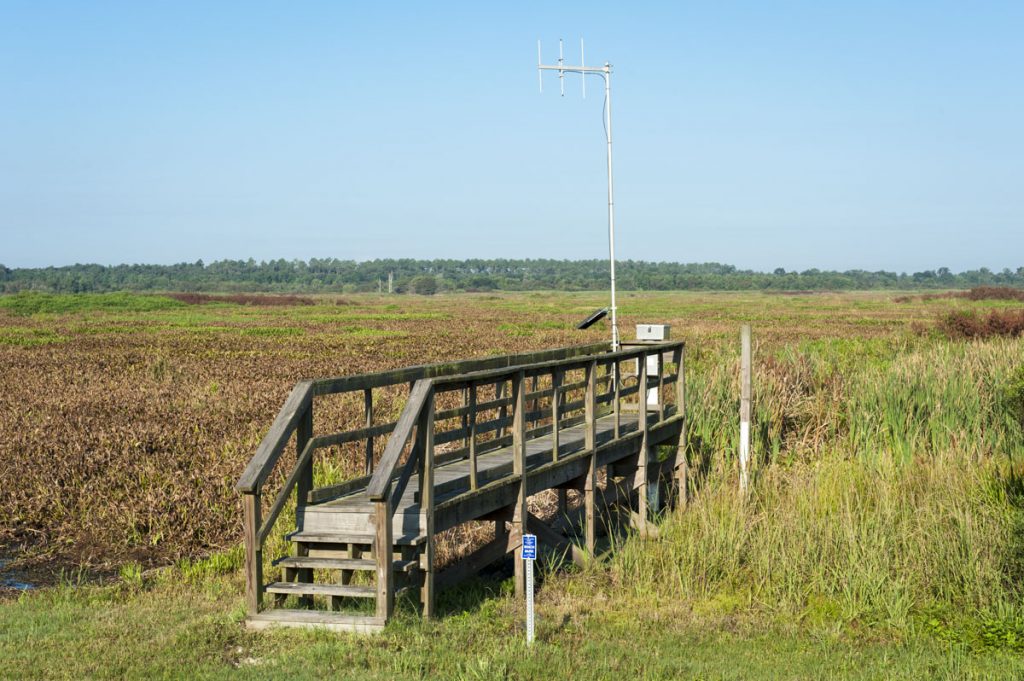Resources

Monitoring networks
Overview of Groundwater monitoring networks
The St. Johns River Water Management District operates and maintains groundwater monitoring networks used to evaluate the response of the hydrogeologic system to changes in climate and the demand to meet growing water supply needs. The goal of groundwater monitoring is to improve the understanding of the hydrogeologic system through a long-term, systematic data collection of groundwater levels and quality from monitoring wells and discharge and water quality from springs. Long-term data collection provides the data needed to evaluate current aquifer conditions, to detect changes and trends over time, and to develop groundwater models used in water supply planning.
Groundwater monitoring networks provide the data and information used to evaluate the hydrostratigraphic aquifer and confining units in the district. The geologic structure and lithostratigraphy of peninsular Florida control the nature and distribution of the hydrostratigraphic units and have a distinct influence on the storage, movement and quality of groundwater. The hydrostratigraphic units in the district include the surficial aquifer, the intermediate confining unit, and the units within the Floridan aquifer system. The Floridan aquifer system includes the Upper Floridan aquifer (UFA), the middle confining units I and II, and the Lower Floridan aquifer. The UFA includes the Ocala permeable zone (upper part of the UFA), the Ocala low permeable zone, and the Avon Park permeable zone (lower part of the UFA).
Resource assessment staff responsibilities include:
- Construct and maintain monitoring network wells for hydrogeologic evaluations and for long-term data collection of groundwater levels and water quality
- Maintain spring network for discharge, pool elevation and water quality data collection
- Evaluate and refine the networks to optimize spatial and temporal data collection to meet water management needs
- Evaluate and analyze the hydrologic and geologic data collected from the networks using statistical and mapping methods to produce useful information that increases our understanding of the hydrogeologic, climatic and human factors that affect groundwater resources
- Distribute and publish the network data, information and hydrogeologic evaluations as required by users for water supply planning, minimum flows and levels, consumptive use permitting and other district programs
Groundwater level monitoring
The groundwater level monitoring network was developed based on knowledge of the hydrogeologic system and the spatial, temporal and statistical evaluation of historical water level data. As of September 2012, there are 740 wells in the groundwater level monitoring network in the district.
Groundwater levels reflect the balance between recharge to, storage, and discharge from the hydrostratigraphic aquifer units in the groundwater system. The physical and hydraulic properties of the aquifers, climatic conditions and human factors control this balance. Groundwater levels in peninsular Florida generally show a natural cyclical pattern of seasonal fluctuation, typically rising in the summer and fall seasons and falling in the winter and spring due to the effects of climate and groundwater demand for various uses. The magnitude of water level fluctuations can vary from season to season and year to year in response to climatic events of varying magnitude and duration. The record of groundwater level measurements over time, displayed as a hydrograph, reveals general hydrologic trends and provides information about how aquifers with different hydrogeologic characteristics respond to climatic conditions and groundwater use.
Groundwater flow patterns in the hydrogeologic system are controlled primarily by the geologic characteristics and hydraulic heads, or hydraulic pressure differences, among the aquifer units. The distribution of hydraulic heads is controlled by the relative hydrostratigraphic unit elevations, the location and effectiveness of recharge and discharge areas, aquifer confinement, and aquifer permeability and transmissivity. Well clusters at many monitoring locations provide data on the characteristics of the aquifer units with depth. Well clusters at a particular site typically include two to four observation wells that monitor distinct permeable zones.
Water levels for most wells in the network are monitored continuously as part of a telemetry system or by digital recorders. Manual water level readings are taken monthly or at lesser intervals for some wells. Because the extent and nature of groundwater resources are not confined by political boundaries, the St. Johns District also obtains hydrologic data from neighboring water management districts and the state of Georgia for use in hydrogeologic investigations.
Groundwater quality monitoring
The major focus of the district’s groundwater quality monitoring is the Floridan aquifer system, which is the primary source of water for public supply and other uses in most areas. Most of the 340 monitoring wells in the water quality network (as of September 2012) monitor the Ocala permeable zone of the Upper Floridan aquifer, with additional wells monitoring the Avon Park permeable zone (lower permeable zone of the Upper Floridan), and the Lower Floridan aquifer. Water quality samples are also collected at 21 springs.
The chemical composition and the physical properties of water in the hydrostratigraphic aquifer units represent the net effect of the processes that have dissolved, altered or precipitated the chemical constituents. Rainfall chemistry, land surface features, soil types, and recharge, discharge, and leakance relationships among aquifers influence groundwater quality. The lithology, structure and porosity of aquifer materials and the residence time of water affects the precipitation and dissolution of minerals as water moves along flow paths. Land uses, groundwater withdrawals and irrigation may also have an impact on groundwater quality.
The groundwater quality monitoring network provides the data and information used to characterize the major ion chemistry of the aquifer units and to describe a water quality variable’s spatial variability, temporal trend and changes with depth at a specific location. The network is designed to minimize wells and sampling frequency in areas that have shown little water quality variability over time. This allows for increased well coverage and sampling frequency in areas that have significantly increasing trends in water quality variable concentrations, in areas near the potable and nonpotable groundwater interface, in areas of seawater intrusion along parts of the Atlantic coast, and in areas with projected Floridan aquifer water level drawdowns.
Wells are sampled at frequencies of once or twice per year, depending upon the historical water quality data and the location of the well relative to areas of groundwater quality concern. Wells and springs are sampled for the chemical constituents (major cations and anions) typically used as general indicators of groundwater quality. The major cations include calcium, magnesium, sodium and potassium; anions include chloride, sulfate and alkalinity. The concentration of total dissolved solids is also analyzed. Field measurements include temperature, pH, specific conductance and dissolved oxygen. Springs are sampled quarterly, with samples also analyzed for nutrient parameters. Spring water quality monitoring provides vital information about the chemistry and nutrient content of baseflow to stream and river systems.
For additional information, see the report describing the St. Johns River Water Management District groundwater quality monitoring network, an assessment of the major ion chemistry of water for each aquifer, and geochemical patterns of water in the Floridan aquifer system.


